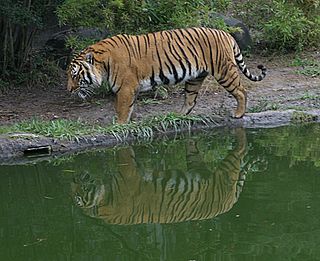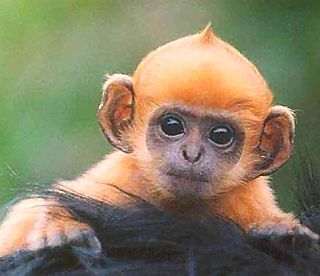
The Pythonidae, commonly known as pythons, are a family of nonvenomous snakes found in Africa, Asia, and Australia. Among its members are some of the largest snakes in the world. Ten genera and 42 species are currently recognized.

Bushmeat is meat from wildlife species that are hunted for human consumption, most often referring to the meat of game in Africa. Bushmeat represents a primary source of animal protein and a cash-earning commodity for inhabitants of humid tropical forest regions in Africa, Latin America and Asia. Bushmeat is an important food resource for poor people, particularly in rural areas.

The Bioko drill is a subspecies of the drill, an Old World monkey. It is endemic to Bioko Island, Equatorial Guinea, located off the west coast of Africa. The drill is one of the largest monkey species, and is considered endangered. The Bioko drill was separated from their mainland counterpart, due to rising sea levels after the end of the last ice age, around 10,000 years ago. The capital of Equatorial Guinea, Malabo, is on Bioko Island. The Malabo market is the primary point of sale for bushmeat on Bioko Island. The drill plays an important role in the cultural tradition of bushmeat consumption, and is locally considered to be tasty, and in some regions, a delicacy. The commercialisation of hunting on Bioko Island has made this practice unsustainable. Hunting of the Bioko drill is banned in most areas of Bioko Island, as they predominantly inhabit protected areas on the island. However, the ban is considered ineffective; hunting remains the largest threat to the drill's population.

The wildlife of Laos encompasses the animals and plants found in the Lao People's Democratic Republic, a landlocked country in southeastern Asia. Part of the country is mountainous and much of it is still clad in tropical broadleaf forest. It has a great variety of animal and plant species.

The wildlife of the Democratic Republic of the Congo includes its flora and fauna, comprising a large biodiversity in rainforests, seasonally flooded forests and grasslands.

The red-eared guenon, also called red-eared monkey, or russet-eared guenon is a primate species in the family Cercopithecidae. It is native to subtropical and tropical moist lowland forests in Cameroon, Equatorial Guinea and Nigeria. It is listed as Vulnerable on the IUCN Red List and is threatened by habitat loss, illegal bushmeat hunting and pet trade.

The Congo clawless otter, also known as the Cameroon clawless otter, is a species in the family Mustelidae. It was formerly recognised as a subspecies of the African clawless otter.

The tree pangolin is one of eight extant species of pangolins, and is native to equatorial Africa. Also known as the white-bellied pangolin or three-cusped pangolin, it is the most common of the African forest pangolins.

Armillifer is a genus of tongue wormss in the subclass Pentastomida. It contains the following species:

Armillifer armillatus is a species of tongue worm in the subclass Pentastomida occurring in tropical Africa. Its typical definitive hosts are pythons, such as the African rock python, while rodents are presumed to act as intermediate hosts. Humans may become accidentally infected by the eggs particularly if consuming infected snakes. Ingested eggs develop into nymphs that invade different visceral organs causing a disease called porocephalosis. Humans have been infected by eating undercooked snake meat or through direct contact. Most human infections are asymptomatic, some are debilitating, or rarely even lethal. Diagnoses of infection has usually been done by accident, and almost all patients did not require treatment.

Walter's duiker is a species of duiker found in Togo, Benin and Nigeria. It was described in 2010. Its name commemorates Professor Walter Verheyen, who was the first to obtain a specimen of this species of duiker from Togo in 1968.

Wildlife farming refers to the raising of traditionally undomesticated animals in an agricultural setting to produce: living animals for canned hunting and to be kept as pets; commodities such as food and traditional medicine; and materials like leather, fur and fiber.

The Laotian giant flying squirrel is an arboreal, flying squirrel endemic to Laos. It was the second described member in the genus Biswamoyopterus, after being first collected in September 2012 by scientists researching the animal corpses in the illegal Thongnami bushmeat market, Ban Thongnami, Pakkading District, Bolikhamxai Province.

Armillifer grandis is a species of tongue worm in the subclass Pentastomida found in tropical Central and West Africa. Its typical definitive hosts are viperid snakes, while rodents are presumed to act as intermediate hosts. Humans may become accidentally infected by the eggs, particularly if consuming infected snakes. Ingested eggs develop into nymphs that invade different visceral organs, causing a disease that is often called porocephalosis. Most human infections are asymptomatic, some are debilitating, or rarely even lethal. Abdominal infections are more widespread, but typically undiagnosed, while ocular manifestations are rare and may cause blindness.

Bats are eaten by people in parts of some Asian, African, Pacific Rim countries and cultures, including China, Vietnam, Seychelles, the Philippines, Indonesia, Palau, Thailand, and Guam. Half the megabat species are hunted for food but only eight percent of the insectivorous bat species are. In Guam, Mariana fruit bats are considered a delicacy.

The pangolin trade is the illegal poaching, trafficking, and sale of pangolins, parts of pangolins, or pangolin-derived products on the black market. Pangolins are believed to be the world's most trafficked mammal, accounting for as much as 20% of all illegal wildlife trade. According to the International Union for Conservation of Nature (IUCN), more than a million pangolins were poached in the decade prior to 2014.

Monkey meat is the flesh and other edible parts derived from monkeys, a kind of bushmeat. Human consumption of monkey meat has been historically recorded in numerous parts of the world, including multiple Asian and African nations. Monkey meat consumption has been reported in parts of Europe and the Americas as well.

The African vulture trade involves the poaching, trafficking, and illegal sale of vultures and vulture parts for bushmeat and for ritual and religious use, like traditional medicines, in Sub-Saharan Africa. This illegal trade of vultures and vulture parts is contributing to a population crisis on the continent. In 2017, the IUCN Red List categorized 7 of Africa's 11 vulture species as globally endangered or critically endangered. Recent research suggests that 90% of vulture species declines in Africa may be due to a combination of poisoning and illegal wildlife trade for medicinal use and/or bushmeat. All trade of African vultures is illegal, as these birds are protected by international laws.

Linguatulidae is a family of crustaceans belonging to the order Porocephalida.

Porocephalidae is a family of crustaceans belonging to the order Porocephalida.



















